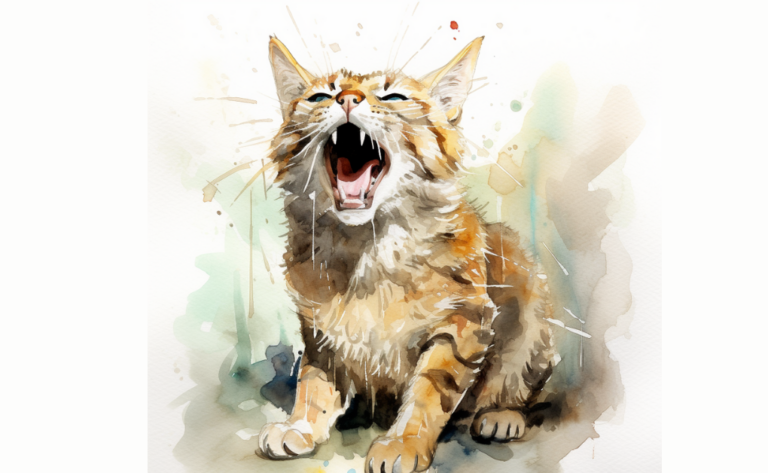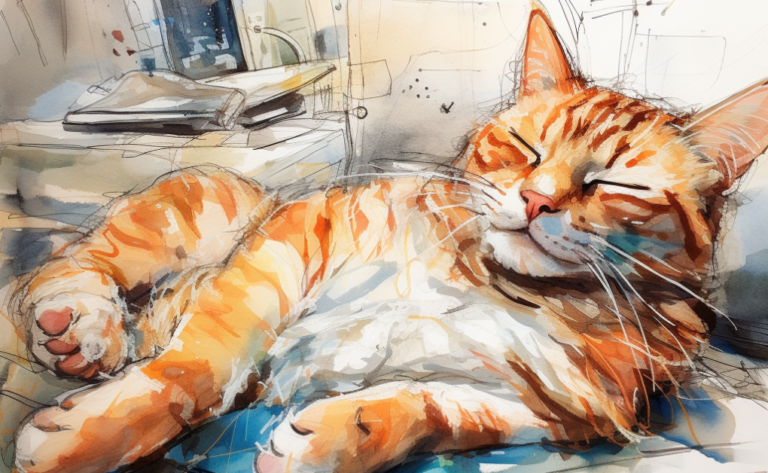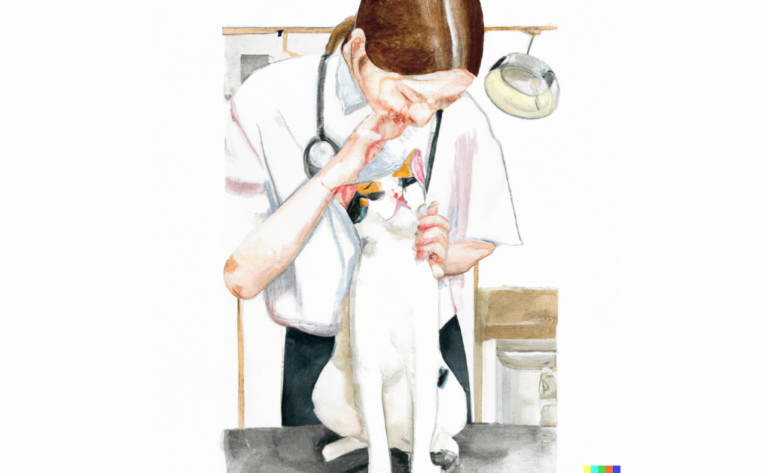What Is Atopic Dermatitis in Cats?
What is it?
How is it Treated?
Breed Predispositions
Siamese and Himalayan cats
Introduction
As the days grew warmer, Rachel noticed her usually content and carefree Persian cat, Muffin, constantly scratching and grooming herself, leaving red, irritated patches on her skin. Concerned for her beloved pet’s comfort and health, Rachel scheduled an appointment with her veterinarian for a thorough examination. After careful evaluation, the vet diagnosed Muffin with atopic dermatitis, a common skin condition that affects cats of all breeds.
Atopic dermatitis, or atopy, is a chronic skin disease prevalent in cats. It’s characterized by a hypersensitivity or overactive immune response to various environmental allergens. The condition tends to develop early in a cat’s life, often by age two. With this condition, cats experience inflammation and irritation of the skin. Over time, the symptoms may become persistent and affect the cat year-round. Managing atopic dermatitis effectively is essential as it can considerably impact a cat’s quality of life.
The Types of Atopic Dermatitis in Feline
Flea Allergy Dermatitis (FAD)
Flea Allergy Dermatitis (FAD) in cats is a hypersensitive reaction to the antigens or proteins found in flea saliva. When a flea bites a cat to feed on its blood, it injects saliva into its skin. Some cats are allergic to this saliva, which can cause severe itching and inflammation, even from a single bite.
FAD is the most common dermatologic disease in cats, and controlling the cat’s flea population and environment is critical for managing this condition.
Food Allergy Dermatitis
Food Allergy Dermatitis in cats is a type of allergic reaction that occurs when a cat is sensitive or intolerant to certain ingredients in their diet. The allergen can be a type of protein, carbohydrate, preservative, or food coloring, with the most common food allergens in cats being fish, beef, chicken, and dairy products.
Unlike other types of allergies that affect cats, food allergies are not seasonal and can occur at any age. The reaction from food allergies can cause skin inflammation, itchiness, and chronic ear infections.
Inhalant Allergy (Atopy)
Inhalant Allergy, also known as Atopy, in cats is an allergic reaction caused by substances that cats inhale from their environment. The allergens can be dust mites, mold spores, pollen from trees, grasses, and weeds, or animal dander from other pets.
These airborne allergens are typically harmless to many animals, but in cats with Atopy, they trigger an overactive immune response. This immune response leads to inflammation and irritation in the skin, primarily causing itchiness. And 10-25 percent of animals with atopic eczema are due to airborne allergens.
Contact Dermatitis
Contact Dermatitis in cats is a type of skin inflammation that occurs when a cat’s skin comes into direct contact with certain substances that trigger an allergic or irritant reaction. These substances could be various items in a cat’s environment, such as certain fabrics, rubber or plastic materials, certain plants, chemicals used in cleaning products or flea collars.
In allergic contact dermatitis, the cat’s immune system overreacts to a typically harmless substance, triggering inflammation in the skin. The substance physically damages the skin for irritant contact dermatitis, causing inflammation.
The skin reaction typically occurs on the parts of the body that have made contact with the allergen, such as the paws, belly, or face. The affected skin may appear red, swollen, and itchy, leading to discomfort for the cat. Unlike some other types of dermatitis, contact dermatitis can often be managed by identifying and avoiding the offending substance.
What are the Causes of Atopic Dermatitis in Cats?
An exaggerated immune response to certain environmental allergens causes atopic dermatitis in cats. While the exact cause is unknown, it is believed to involve a combination of genetic predisposition and environmental triggers. Here are the primary causes:
- Genetics: Certain cat breeds seem more prone to atopic dermatitis, suggesting a genetic component. If a cat’s parents have atopic dermatitis, it may be more likely to develop the condition.
- Allergens: The most common triggers for atopic dermatitis in cats are allergens present in the environment. These can include pollen from grass, trees, weeds, mold spores, dust mites, and certain foods. Cats can be exposed to these allergens through skin, inhalation, or diet.

- Fleas: Flea allergy dermatitis is a common atopic dermatitis in cats. Even if fleas are not currently present, previous flea bites may cause a lingering sensitivity in the skin.
- Food Allergies: Some cats develop atopic dermatitis in response to certain ingredients in their food. This type of food allergy can develop even if the cat has been eating the same food for a long time without issues.
- Contact Allergens: Some cats may react to substances they encounter, such as certain types of plastic, fabrics, or chemicals. This form of atopic dermatitis is less common but can occur.
Remember, atopic dermatitis is typically a lifelong condition that requires ongoing management. Once a cat develops atopic dermatitis, it may be more susceptible to skin infections and other skin conditions due to the changes in the skin’s barrier function and increased scratching.
Cat Flea Allergy Dermatitis
Flea allergy dermatitis (FAD) in cats is a common form of atopic dermatitis caused by an allergic reaction to flea saliva. When a flea bites a cat to feed, it injects saliva into its skin. Some cats are allergic to this saliva and develop flea allergy dermatitis.
The allergic reaction is a hypersensitivity response, which means the cat’s immune system overreacts to a relatively harmless substance (in this case, flea saliva). This overreaction causes inflammation and itchiness.
It’s important to note that all cats in a household should be treated for fleas if one cat is diagnosed with FAD, even if the other cats do not show symptoms. This is because fleas can easily spread between cats and can survive in the environment for months.
Cat with Food Allergy
Food allergy dermatitis in cats is when a cat’s immune system reacts abnormally to a certain food or ingredient. These allergies can develop to any food or ingredient, but common allergens in cats include beef, dairy products, chicken, fish, and certain grains.
It’s important to note that a food allergy differs from a food intolerance. Food intolerance does not involve an immune system response. It is typically related to the cat’s inability to digest certain types of food. In contrast, a food allergy is an immune system reaction to a food or ingredient that the cat’s body perceives as threatening.
Environmental Allergies
Environmental allergies, or atopy, refer to a cat’s allergic reaction caused by various environmental substances. These substances, known as allergens, are typically harmless to most animals. However, in cats with atopy, the immune system overreacts to these allergens, causing an allergic response.
Common environmental allergens for cats include pollen from trees, grasses, weeds, mold spores, dust mites, and animal dander. The cat can inhale these allergens or come into contact with the skin, triggering an allergic response.
Like humans, cats with environmental allergies may experience itchy skin, redness, swelling, and discomfort. This condition often manifests as dermatitis, an inflammation of the skin. In addition, cats may scratch, chew, or lick excessively at the affected areas, causing further skin damage, potential hair loss, and secondary skin infections.
Symptoms of Atopic Dermatitis in Cats
The symptoms of atopic dermatitis in cats can vary, but here are the most common ones:
- Excessive scratching, licking, and grooming
- Redness and inflammation of the skin
- Skin rashes or lesions
- Hair loss (alopecia)
- Recurrent skin infections
- Ear infections (otitis)
- Changes in the skin’s color or texture
- Areas of thickened skin
- Watery eyes or conjunctivitis
- Runny nose or sneezing (in cases where allergens are inhaled)
- Gastrointestinal problems such as vomiting or diarrhea (often seen in food allergies)
It’s important to note that these symptoms can also be seen with other conditions. Hence, a thorough veterinary examination and appropriate diagnostic tests are necessary to confirm the diagnosis of atopic dermatitis.
Diagnosis of Atopic Dermatitis in Cats

Atopic dermatitis in cats is diagnosed through clinical signs, history, and exclusion of other similar conditions. This can be a complex and multi-step process due to the nature of the disease and the numerous other conditions that can cause similar symptoms. Here’s a general overview of how veterinarians might approach the diagnosis:
- Medical History and Physical Examination: The vet will start by taking a detailed history of your cat’s health, including the onset of symptoms, their duration and frequency, and whether there’s any seasonal pattern to the symptoms. They’ll perform a thorough physical examination, paying special attention to the skin. Signs of atopic dermatitis in cats often include itching, redness, and skin lesions, typically affecting the face, neck, and front paws.
- Exclusion of Other Conditions: Atopic dermatitis shares symptoms with several other skin conditions, so the vet must rule these out. These might include flea allergy dermatitis, food allergies, and parasitic or fungal infections. This process might involve a flea control trial, a diet trial, skin scrapings to check for mites, fungal culture or other tests.
- Intradermal Allergy Testing (IDAT): Once other conditions have been ruled out, the vet might perform intradermal allergy testing, which involves injecting small amounts of common allergens into the skin to see if they cause a reaction. This can help confirm the diagnosis and identify the specific allergens causing the reaction.
- Serological Allergy Testing: This blood test measures the level of antibodies to specific allergens in the blood. It’s less commonly used than IDAT, and the two tests may sometimes be used together.
- Response to Treatment: In some cases, the vet might choose to treat the cat for atopic dermatitis and see if the symptoms improve, which can help confirm the diagnosis.
Remember, atopic dermatitis is a complex condition that can be challenging to diagnose and manage, so it’s crucial to work closely with your vet and follow their advice. If your cat is diagnosed with atopic dermatitis, it usually requires lifelong management to control symptoms.
Treatment of Feline Atopic Dermatitis
The treatment of atopic dermatitis in cats is tailored to the individual pet’s needs and can involve a combination of strategies:
Elizabeth Collar
An e-collar, an Elizabethan collar or “cone,” can effectively treat and manage atopic dermatitis. Here’s how:
- Prevents Self-Trauma: The primary function of an e-collar is to prevent cats from causing further harm to themselves. It acts as a barrier, preventing the cat from reaching the affected skin areas with its mouth or claws. This allows the inflamed skin the chance to heal.
- Helps Medication Work: When topical medications are used, cats can quickly lick them off, reducing their effectiveness. An e-collar ensures these treatments stay on the skin long enough to be absorbed properly and provide relief.
- Reduces Secondary Infections: By stopping the cat from scratching or licking the irritated skin, the e-collar also helps prevent secondary bacterial or yeast infections that can develop in the damaged skin.
Allergen Avoidance
In managing atopic dermatitis in cats, allergen avoidance is a cornerstone of the treatment plan. This includes altering the cat’s diet to a hypoallergenic or novel protein diet if a specific food is an allergen or enforcing complete flea control if fleas are the source of the allergy. Altering the cat’s environment may also be necessary, such as replacing allergenic materials in the home, using air purifiers for inhalant allergens, or restricting outdoor time during periods of high pollen count. The aim is to minimize exposure to allergens, reduce allergic reactions, and improve the cat’s comfort and health.
Topical Treatments
Topical treatments play a significant role in managing atopic dermatitis in cats. These treatments are applied directly to the skin or coat and can relieve symptoms like itching and inflammation and help promote skin healing.
- Shampoos and Conditioners: Medicated shampoos and conditioners can soothe irritated skin, control infection, and reduce inflammation. Some contain ingredients that provide a barrier to protect the skin. These products should be used as directed by the veterinarian, who will choose a product based on the cat’s specific needs.
- Creams and Ointments: Medicated creams and ointments can be applied directly to the affected areas of the skin. They often contain corticosteroids to reduce inflammation and antibiotics or antifungals to control secondary infections.
- Spot-On Treatments: Spot-on treatments are liquids applied directly to the skin, usually at the back of the neck. They can provide systemic effects throughout the body, particularly helpful for flea allergy dermatitis. In addition, they might contain ingredients that kill or repel fleas, other parasites, or substances that help soothe the skin.
- Sprays: Anti-inflammatory sprays can help to soothe and heal inflamed skin. They are especially useful in cats that don’t tolerate other topical treatments well.
- Wipes: Medicated wipes can be useful for cleansing the skin and provide soothing and antimicrobial properties. They’re especially handy for cleaning localized areas between the toes or around the face.
It’s essential to remember that cats groom themselves by licking their fur, so any product applied topically must be safe if ingested. Always consult with a veterinarian before starting any new topical treatment. They can guide you on the best choices for your cat’s condition and needs.
Oral Medications
Oral medications can be a significant component of the treatment plan for cats with atopic dermatitis. These can help manage the symptoms of the disease and improve the cat’s quality of life.
- Steroids: Corticosteroids, like prednisolone, are potent anti-inflammatory drugs that can provide rapid relief from itching and inflammation. However, they should be used for the shortest period possible due to potential side effects, such as increased thirst, urination, and appetite. Long-term use can lead to more severe side effects like diabetes and Cushing’s’ disease.
- Antihistamines: These medications can help reduce itching in some cats. However, they are generally less effective in cats than humans or dogs. Antihistamines are often combined with other treatments and can have a mild sedative effect.
- Cyclosporine: This immunosuppressive drug can be very effective in controlling the signs of atopic dermatitis. It generally has fewer side effects than long-term steroid use. However, it’s more expensive and may take several weeks to start working.
- Fatty Acid Supplements: Omega-3 and omega-6 fatty acid supplements can help improve skin health and reduce inflammation. They are often used in conjunction with other treatments.
- Antibiotics or Antifungals: Oral antibiotics or antifungal medications may be prescribed if the cat has a secondary bacterial or fungal infection due to excessive scratching.
- Apoquel and Cytopoint: These newer medications specifically target itch and inflammation pathways, reducing the urge to scratch without many side effects associated with steroids. Apoquel is an oral medication, while Cytopoint is an injectable medication that works for 4-8 weeks per injection.
Each cat is an individual, and what works for one might not work for another. Therefore, the treatment plan may need to be adjusted based on the cat’s response to the medication. As with all medications, it’s crucial to discuss potential side effects and monitor the cat closely while they are taking the medication.
Immunotherapy
Immunotherapy is an innovative approach to managing atopic dermatitis in cats, particularly for those who do not respond well to conventional treatments or for whom these treatments are not advisable.
Immunotherapy involves desensitizing the cat’s immune system to allergens to which it is hypersensitive. This is accomplished by gradually exposing the cat to minute amounts of the allergen(s), thereby ‘training’ the immune system not to overreact. This method can be highly effective, especially when the allergens causing the reaction have been accurately identified.
The allergens are usually administered through injections, known as allergen-specific immunotherapy (ASIT), or orally as sublingual immunotherapy (SLIT). Allergen-specific Immunotherapies are considered safe and successful, with success rates ranging between 60%-78%. The treatment starts with very small doses, gradually increasing over time. The allergens include pollen, mold, dust mites, and certain foods.
It’s important to note that immunotherapy is not a quick fix. It may take months to see a significant improvement, and it doesn’t work for all cats. However, for those it does help, the benefits can be substantial and long-lasting. Immunotherapy is generally considered a safe treatment option. Still, as with all treatments, it should be administered under the supervision of a vet, and the cat should be monitored for any adverse reactions.
Fatty Acid Supplements
Fatty acid supplements, primarily omega-3 and omega-6, can be an effective part of the treatment plan for feline atopic dermatitis due to their anti-inflammatory effects and ability to support skin health. Sourced from fish and plant oils, these fatty acids help hydrate the skin, improve its texture, and alleviate dermatitis symptoms. It’s important to note that these supplements, which can be added to the cat’s food, may take a few weeks to show results. Prior to introducing these supplements, it’s recommended to consult with a vet for appropriate dosage and to ensure safety. High-quality, veterinary-grade products from reputable manufacturers are preferred for their effectiveness and safety.
Medications to Control Secondary Infections
In the case of feline atopic dermatitis, secondary bacterial and yeast infections are common complications due to damage to the skin barrier and increased skin moisture from excessive licking and grooming. These infections can exacerbate the cat’s symptoms and contribute to a worsening of the disease. Therefore, treating these secondary infections and managing the underlying allergy is often necessary.
- Antibiotics and antifungal medications are commonly used for this purpose. The choice of medication depends on the type of infection present, determined by the vet through testing, such as skin cytology or culture.
- Antibiotics are effective against bacterial infections. They can be administered orally, topically as creams or ointments, or sometimes as an injectable medication. The treatment course is typically a few weeks long but may be extended if the infection is severe or chronic.
- Antifungal medications treat yeast infections, often caused by the fungus Malassezia. Like antibiotics, they can be given orally or applied topically, depending on the severity and location of the infection.
It’s crucial to complete the full course of medication, even if the symptoms seem to have resolved, to eliminate the infection and reduce the risk of resistance developing. The vet may also recommend medicated shampoos or conditioners to help manage these secondary infections and soothe the skin.
It’s always recommended to consult a vet for the appropriate treatment regimen for secondary infections in cats with atopic dermatitis, as the specific medication and dosage depend on the individual cat’s condition and overall health.
Cyclosporine
Cyclosporine is a potent immunosuppressive drug that’s often used in the treatment of atopic dermatitis in cats. It works by inhibiting the activation and function of certain immune cells responsible for the inflammatory response seen in allergic skin diseases. By suppressing this immune response, cyclosporine can reduce the symptoms of atopic dermatitis, such as itching, redness, and skin lesions.
Cyclosporine is usually given orally, and its effect often becomes noticeable within a few weeks of starting the treatment. It’s particularly beneficial for cats that have not responded well to other treatments or for those for which long-term steroid use isn’t desirable due to potential side effects.
While cyclosporine is generally well-tolerated by cats, it can have some side effects, including gastrointestinal issues such as vomiting and diarrhea and potential changes in coat texture. It may also affect kidney function less commonly, so regular veterinary check-ups and occasional blood tests are typically recommended to monitor the cat’s health during treatment.
Hypoallergenic Diet
A hypoallergenic diet can be essential to the treatment plan for cats with atopic dermatitis, particularly those suspected of food allergies. This diet usually includes novel proteins and carbohydrates, which the cat hasn’t been exposed to before, reducing the likelihood of an allergic response. Sometimes, a vet may recommend hydrolyzed diets, where proteins are broken down into smaller molecules that are less likely to trigger allergies. Strict adherence to the hypoallergenic diet is critical, carefully evaluating all food items, including treats, supplements, and medication. A diet trial should run for several weeks to months under the supervision of a vet or veterinary nutritionist. The goal is to minimize atopic dermatitis symptoms and improve the cat’s quality of life.
Recovery of Atopy in Cats
Atopic dermatitis in cats is a chronic condition that can’t be cured but can be managed with a long-term care plan designed to minimize symptoms and improve the cat’s quality of life. Despite a well-implemented treatment plan, cats may experience occasional flare-ups, especially when exposed to triggering allergens. The severity and frequency of these flare-ups can be reduced with ongoing treatments such as topical creams, oral medications, dietary changes, and sometimes immunotherapy.
Regular vet check-ups are crucial to monitor the treatment’s effectiveness and make necessary adjustments. Recovery depends on various factors, including the condition’s severity, the cat’s response to treatment, and how effectively allergens are avoided. Maintaining regular vet contact and the treatment regimen is key for the cat’s comfort and well-being, as atopic dermatitis is lifelong. With proper diagnosis, treatment, and management, cats with atopic dermatitis can lead comfortable, happy lives.
How to Prevent Feline Atopic Dermatitis?
Preventing atopic dermatitis in cats can be challenging because the condition is often linked to an inherited predisposition. However, there are strategies that you can employ to minimize the risk and severity of flare-ups:
- Allergen Avoidance: Once the allergens triggering your cat’s symptoms have been identified, do your best to remove these from your cat’s environment. This might involve frequent cleaning to reduce dust mites, avoiding certain types of plants, or using unscented, hypoallergenic laundry detergents and cleaning products.
- Diet: Some cats might be predisposed to food allergies, which can contribute to atopic dermatitis. Feeding a high-quality, hypoallergenic diet can help reduce potential food allergens. Always consult your vet before significantly changing your cat’s diet.
- Skin Care: Regular grooming can help keep your cat’s skin and coat healthy, reducing the risk of skin infections that can exacerbate atopic dermatitis. Your vet may recommend specialized shampoos or topical solutions.
- Regular Vet Checks: Regular veterinary examinations can help catch any signs of atopic dermatitis early, potentially reducing the severity of the condition. Schedule a vet visit if you notice any changes in your cat’s behavior or appearance, such as increased scratching or changes in the skin or coat.
- Flea Prevention: Regular flea prevention treatments are essential, as flea allergy dermatitis can trigger or exacerbate atopic dermatitis.
Remember, prevention methods largely depend on your cat’s allergens and overall health status. Always consult your veterinarian to devise an effective preventive plan for your cat.
Frequently Asked Questions
Disclaimer: The information provided on this veterinary website is intended for general educational purposes only and should not be considered as a substitute for professional veterinary advice, diagnosis, or treatment. Always consult a licensed veterinarian for any concerns or questions regarding the health and well-being of your pet. This website does not claim to cover every possible situation or provide exhaustive knowledge on the subjects presented. The owners and contributors of this website are not responsible for any harm or loss that may result from the use or misuse of the information provided herein.







